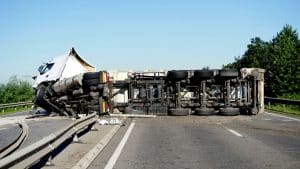Truck Accidents and Black Box Data
 When you get hurt in a car crash, we use a lot of different sources to show you’re not at fault: tire tracks on the road, the damage to your vehicle, any video or pictures of the collision, and so forth. In a truck accident, though, we have an extra ace up our sleeve: the Event Data Recorder, or “black box.”
When you get hurt in a car crash, we use a lot of different sources to show you’re not at fault: tire tracks on the road, the damage to your vehicle, any video or pictures of the collision, and so forth. In a truck accident, though, we have an extra ace up our sleeve: the Event Data Recorder, or “black box.”
The black box is typically located in the truck’s electronic control module (ECM). The ECM is like the brain of the truck: it runs a number of different systems that monitor both the truck’s operation as well as the driver’s behaviors. The black box, specifically, records and stores critical data about a vehicle’s performance, movement, and other metrics – including vehicle speed, brake application, engine RPM, seatbelt activation, airbag deployment, and more – right before an “event,” like a crash.
In other words, the ECM runs continuously; most black boxes only start recording once there’s a reason to record, like sudden deceleration or a tightening of the driver’s seatbelt. (Sometimes, a black box runs continuously; it depends on the device.)
How can a black box help with my Minot truck accident case?
Black box data can help prove (or disprove) the accounts of the parties involved in a truck accident. For example, say a truck driver claims they properly and promptly applied their brakes in an attempt to avoid a collision. The black box data can confirm this for the driver by showing exactly when the driver applied their brakes, and how quickly the truck slowed down. Or, it might show that the driver in fact did not slow down and instead applied the brakes hard at the last minute.
In some ways, black boxes are the first key to showing that an event happened at all. If a driver claims that he was hit by a truck, the truck’s back box will record it. And we can use that data to help folks who have been injured in crashes with trucks. If the black box recorder does not record any impact (as in, no tightening of the seat belts, no change in speed, no indication of sudden braking), that information will be very helpful for truck drivers who claim they did not have an accident.
One other thing a truck’s black box might indicate: mechanical failure. Say a commercial truck blows a tire while it’s traveling down US 83. That tire blowout can cause the trucker to lose control, and the black box will record the response of the truck and the truck driver. This data, along with the debris from the tire, can show that it was the tire that led to the crash.
What can’t a black box do?
Black boxes can’t offer any insight into non-events. For example, say Driver A claims that Trucker B cut him off on the highway, and as a result, Driver A slammed on his brakes and was rear-ended by Driver C. The event data recorder isn’t going to have any proof of that; there was no “event” that occurred, so there’s nothing to record.
It also can’t tell you about the driver. Black boxes can’t say if the driver was breaking the Hours of Service rules (though the Electronic Logging Device, or ELD, certainly can.) It can’t tell you if the driver fell asleep or was distracted at the moment of impact or whether the trucker was trying to avoid hitting black ice when it swerved. It may not tell you if the trucker used a turn signal (though it can tell you the position of the steering wheel). It can’t tell you whether or not the driver was drunk or impaired; all it can do is provide data about the moment of collision – and what happened right after.
Can I use black box data in court?
Yes, you can indeed use black box data as evidence in court proceedings, including in cases such as truck accidents.
How do I get this black box data for my truck accident case?
You don’t; we do. Trucking companies own that data, which means the only way to access it is to request it from the trucking company. We do this through a “spoilation” letter, which basically says “Don’t erase that data because it’s going to be used as evidence in a lawsuit.” Insurance companies can request the data, too, so this is one reason why it’s so important you hire an experienced attorney.
How a Minot truck accident lawyer uses black box data in your case
Once we get the information from the EDR, we need to analyze it. Expert witnesses, like accident reconstruction experts or crash investigators, can analyze the data to recreate the sequence of events leading up to and including the accident. They translate the raw data into real-world scenarios to provide a visual representation of how the accident occurred. This reconstruction can assist in determining who or what was responsible.
But this is not the only information we use. Remember: there are a lot of things the black box won’t record, so we don’t rely solely on this one piece of evidence. We also review:
- Your vehicle’s black box data, if your car has one
- Crash reports from law enforcement
- The physical damage to your vehicle, which can indicate what part of your car was hit directly, and what the car did afterward
- The rest of the ECM data, including any records from the Electronic Logging Device
- Any available video footage, either from your vehicle, the truck, or surrounding surveillance cameras
- The condition of the road where the crash occurred as well as the surrounding areas
- Your medical records, to see the full extent of your injuries and treatment plan
All of this goes into building a truck accident case.
Were you or someone you love injured in a truck accident that wasn’t your fault? Talk to a skilled personal injury attorney from Larson Law today. Call or complete our contact form to schedule a free consultation. We handle accident cases on a contingency fee basis. We have offices in Fargo, Bismarck, and Minot.

Mark Larson is a Certified Civil Trial Specialist and Certified Civil Pre-Trial Specialist focusing on personal injury, car accidents, wrongful death, and oil field claims. Since 1979, Larson Law has served the injured throughout North Dakota. Read more about Mark V. Larson.
